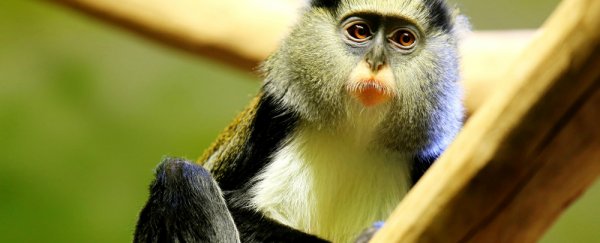Researchers have used human linguistic tools to translate the language of Campbell's monkeys (Cercopithecus campbelli), primates found in western Africa.
For years primatologists and linguists have been studying their advanced language to try to crack the code of monkey vocabulary, but now a team of researchers believe they may have finally done it, all thanks to the monkey term "krak".
They found that Campbell's monkeys in the Ivory Coast's Tai Forest use the term krak to indicate that a leopard is nearby, and the sound "hok" to warn others that there's an eagle circling overhead. You can listen to how these words sound over at Scientific American.
But then the researchers found that on Sierra Leone's Tiwai Island, where there are no leopards, the same monkey species uses krak as a general alarm call for any threat, including eagles.
"Our findings show that Campbell's monkeys have a distinction between roots and suffixes, and that their combination allows the monkeys to describe both the nature of a threat and its degree of danger," the study's lead author, Philippe Schlenker from France's National Centre for Scientific Research and New York University, said in a press release.
To work out what was going on, the researchers played recordings of different types of threats (the sound of an eagle screeching or a leopard growling), and listened to the calls that resulted in the different locations.
On the mainland, they found that the Campbell's monkeys were using a more specific dialect - they were not only saying krak when a leopard was nearby and hok when an eagle was close, but also krak-oo and hok-oo to signify less serious ground and air threats. They also said boom when the coat was clear again.
But on the island, although the monkeys occasionally said hok when an eagle was nearby, they also said krak pretty generally across most threats.
In human language, the way we use words is contextual - we'll usually choose the most informative term to describe something over a vague one. And if we do use a vague word, there's normally a special reason for it. This is a device known as 'implicatures' and it suggests that the meaning of a word can be enriched when it's competing with a more informative alternative.
The press release explains: "For instance, "possible" competes with "certain," which is more informative, and for this reason "possible" usually comes to mean "possible but not certain".
As Krisch writes for Scientific American:
"Schlenker applied the same reasoning to Campbell's monkeys. "The important thing is that in this situation, both krak-oo and hok are more informative than krak," he says. "By logic, if you hear krak you can infer there was a reason krak-oo and hok were not uttered, so you infer the negation." That is, when monkeys in the forest say krak, they are also implying not-hok and not-krak-oo, neither a minor threat nor an aerial threat. In the forest, monkeys understand that this must refer to a leopard - the only non-minor, non-aerial threat nearby.
On the island, however, it remains a general alarm call. That's because krak does not intrinsically imply negation."
The results, which were published in Linguistics and Philosophy, suggest that some monkey dialects are just as nuanced and sophisticated as human language, which is a pretty amazing discovery.
Schlenker now hopes the research can be used to initiate the development of a form of "primate linguistics" - which would involve applying the sophisticated methods from human linguistics to animal communication.
However, some scientists caution that this conclusion still relies on a lot of assumptions.
"Although this current work seems very internally consistent, it does rest on a shaky foundation of correlation," Arik Kershenbaum, a zoologist at the National Institute for Mathematical and Biological Synthesis told Krisch. "Without experimental confirmation the premise is highly speculative indeed."
It's pretty exciting, however, to think that we might slowly be beginning to understand the complex language that animals use, and realising that it's more similar to our own than we initially realised.
Source: Scientific American, Phys.org
